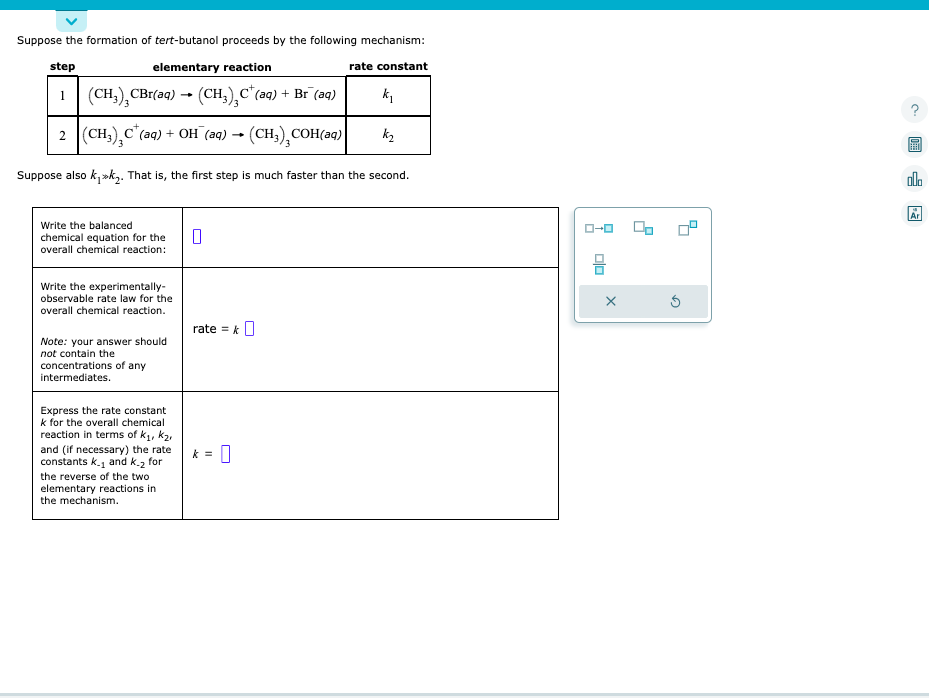Suppose the formation of tert-butanol proceeds by the following mechanism: step elementary reaction rate constant 1 (CH₂), CBr(aq) (CH₂), C* (aq) + Br (aq) k₁ 2 (CH₂), C ¸C²(aq) + OH¯(aq) → (CH₂)₂COH(aq) k₂ Suppose also k₁k₂. That is, the first step is much faster than the second. Write the balanced chemical equation for the overall chemical reaction: Write the experimentally- observable rate law for the overall chemical reaction. Note: your answer should not contain the concentrations of any intermediates. Express the rate constant k for the overall chemical reaction in terms of K₁, K₂, and (if necessary) the rate constants k.₁ and k.2 for the reverse of the two elementary reactions in the mechanism. 0 rate = k = 0 0-0 4 0² 00 X
Suppose the formation of tert-butanol proceeds by the following mechanism: step elementary reaction rate constant 1 (CH₂), CBr(aq) (CH₂), C* (aq) + Br (aq) k₁ 2 (CH₂), C ¸C²(aq) + OH¯(aq) → (CH₂)₂COH(aq) k₂ Suppose also k₁k₂. That is, the first step is much faster than the second. Write the balanced chemical equation for the overall chemical reaction: Write the experimentally- observable rate law for the overall chemical reaction. Note: your answer should not contain the concentrations of any intermediates. Express the rate constant k for the overall chemical reaction in terms of K₁, K₂, and (if necessary) the rate constants k.₁ and k.2 for the reverse of the two elementary reactions in the mechanism. 0 rate = k = 0 0-0 4 0² 00 X
Chapter13: Kinetic Methods
Section: Chapter Questions
Problem 4P
Related questions
Question
Suppose the formation of tert-butanol proceeds by the following mechanism:
| step | elementary reaction | rate constant |
|---|---|---|
|
1
|
CH33CBr
→
CH33C+
+
Br−
|
k1
|
|
2
|
CH33C+
+
OH−
→
CH33COH
|
k2
|
Suppose also
k1
≫
k2
. That is, the first step is much faster than the second.

Transcribed Image Text:Suppose the formation of tert-butanol proceeds by the following mechanism:
step
elementary reaction
rate constant
1
(CH3), CBr(aq) → (CH3), C (aq) + Br (aq)
k₁
2 (CH3), C (aq) + OH (aq) → (CH₂), COH(aq)
k₂
Suppose also k₁k₂. That is, the first step is much faster than the second.
Write the balanced
chemical equation for the
overall chemical reaction:
Write the experimentally-
observable rate law for the
overall chemical reaction.
Note: your answer should
not contain the
concentrations of any
intermediates.
Express the rate constant
k for the overall chemical
reaction in terms of K₁, K₂,
and (if necessary) the rate
constants k.₁ and K-2 for
the reverse of the two
elementary reactions in
the mechanism.
0
rate = k
k = 0
ローロ
00
믐
X
8
olo
Ar
Expert Solution
This question has been solved!
Explore an expertly crafted, step-by-step solution for a thorough understanding of key concepts.
This is a popular solution!
Trending now
This is a popular solution!
Step by step
Solved in 5 steps with 8 images

Knowledge Booster
Learn more about
Need a deep-dive on the concept behind this application? Look no further. Learn more about this topic, chemistry and related others by exploring similar questions and additional content below.Recommended textbooks for you


Chemistry & Chemical Reactivity
Chemistry
ISBN:
9781337399074
Author:
John C. Kotz, Paul M. Treichel, John Townsend, David Treichel
Publisher:
Cengage Learning

Physical Chemistry
Chemistry
ISBN:
9781133958437
Author:
Ball, David W. (david Warren), BAER, Tomas
Publisher:
Wadsworth Cengage Learning,


Chemistry & Chemical Reactivity
Chemistry
ISBN:
9781337399074
Author:
John C. Kotz, Paul M. Treichel, John Townsend, David Treichel
Publisher:
Cengage Learning

Physical Chemistry
Chemistry
ISBN:
9781133958437
Author:
Ball, David W. (david Warren), BAER, Tomas
Publisher:
Wadsworth Cengage Learning,

Chemistry: Principles and Practice
Chemistry
ISBN:
9780534420123
Author:
Daniel L. Reger, Scott R. Goode, David W. Ball, Edward Mercer
Publisher:
Cengage Learning

Chemistry: The Molecular Science
Chemistry
ISBN:
9781285199047
Author:
John W. Moore, Conrad L. Stanitski
Publisher:
Cengage Learning

Principles of Modern Chemistry
Chemistry
ISBN:
9781305079113
Author:
David W. Oxtoby, H. Pat Gillis, Laurie J. Butler
Publisher:
Cengage Learning